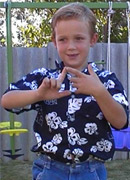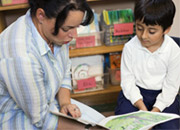Behaviour
Caring for babies
Bottle feeding
Changing a nappy
Cleaning and sterilising bottles
Daily cleaning tasks
Helping new children settle in
Preparing for a nappy change
Sleep patterns – babies
Sleep routines – babies
Toilet training
Caring for children
Allowing time for practice
Dressing/undressing
Mealtimes
Nappy change
Packing away/caring for the environment
Sleep/rest time
Toileting
Common self-help milestones
Tips for sleep and rest time
Self image
Communication
Body language
Limits and guidelines
Ways children communicate
Greeting children and families
Modelling appropriate communication
Questioning
Verbal and non–verbal communication
Acknowledging children's feelings
Listening attentively
Communicating with Aboriginal and Torres Strait Islander parents/carers
Development
Allowing time for practice
Dressing/undressing
Mealtimes
Nappy change
Packing away/caring for the environment
Sleep/rest time
Toileting
Common self-help milestones
Creative development
Language development
Modelling positive relationships
Physical development
Sharing and taking turns
Sleep patterns – babies
Sleep routines – babies
Encourage independent problem solving
Fundamental movement skills
Health, hygiene and safety
Coping with stress
Correct manual handling principles
Daily cleaning tasks
Hand washing
Hand washing poster
Manual handling overview
Toilet training
Safety checklist
Learning experiences and play
Environmentally friendly learning experiences
Learning experiences for different development areas
Creative resource materials
Arranging the environment to facilitate learning and pleasure
Indoors and outdoor areas
Creating a positive physical environment
Legal and ethical issues
Child abuse case studies
How do I recognise when a child or young person is at risk?
Tips on dealing with disclosures
Observation methods
Arranging Experiences (PDF 351Kb)
Recording observations
Rules for making observations
What you can learn from observations
Programming
Children’s interests, strengths, needs and skills
Extending the children’s interest in dinosaurs
Objective observation
Planning an OSHC environment
Behavior management plan
Planning enjoyable experiences
Planning experiences for 0 - 2 years age group
Planning experiences for 2 - 3 years age group
Planning experiences for 3 - 5 years age group
Language development
All people need to be able to communicate with others. The development of communication will assist social development and emotional and psychological development.
Areas of language development
Children’s language skills develop in four distinct modes, as follows.
Children's language skills develop in four distinct modes, represented here by four buttons. Click each button for further information.
Receptive
Receptive language involves a child's understanding of what is being said. For example, the adult says: 'Would you like your bottle now?' and the child nods or makes a sound that indicates understanding.
Expressive
Verbal communication from the child begins with babbling and single words, leading eventually to two- word, then more complicated, sentences. Expressive communication can also consist of non-verbal signals (smiling, nodding, pointing, etc).
Written symbolic
The child starts to recognise symbols, then letters of the alphabet, beginning with the first letter of their own name. You can assist this process by introducing a picture of the child and their name on their place mat, coat rack or bed.
Non-verbal/body language
Children imitate adults and other children as they mature, developing facial expressions, tones of voice, gestures and body movements as forms of communication. The way children display their emotions through their body language will develop over time and vary between individuals.

People who have a hearing impairment may use sign language as another form of verbal communication. Signing is a language that is taught to the hearing impaired. Letters of the alphabet, sentences and expressions such as 'Good' are represented by hand signs.
Ways to develop language skills

Language can be developed through many ways, including:
- talking to babies and children
- repeating sounds back to babies
- pointing out and naming items
- asking open-ended questions
- making comments about what is happening
- participating in experiences and explaining, discussing and questioning
- looking at books, photographs, pictures
- telling stories, reading poems, singing songs
- using puppets and finger-plays
- building ideas or stories on a felt board.